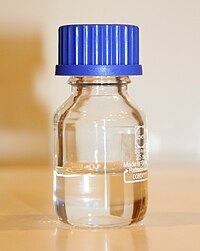
Photo from wikipedia
INTRODUCTION Introducing new and effective antitubercular agents is important in tuberculosis control programs. In this study, the in vitro antitubercular activity of two novel 1,4-dihydropyridine derivatives (F-27, Cl-33) were screened… Click to show full abstract
INTRODUCTION Introducing new and effective antitubercular agents is important in tuberculosis control programs. In this study, the in vitro antitubercular activity of two novel 1,4-dihydropyridine derivatives (F-27, Cl-33) were screened against a total of 113 different strains of Mycobacterium tuberculosis (77 susceptible and 36 resistant clinical isolates). METHODOLOGY The in vitro activities of these compounds were evaluated based on the modified broth macro-dilution assay. RESULTS Compound F-27 showed more than 90% growth inhibition at the range of 2 to 8 μg/mL (minimum inhibitory concentration [MIC]90: 4.13 ± 0.45 µg/mL; p < 0.01), and complete growth inhibition was observed at the range of 8 to 32 μg/mL (minimum bactericidal concentration [MBC]: 11.2 ± 1.65 µg/mL; p < 0.01) against susceptible strains. However, 92% of the resistant strains showed some degree of susceptibility against this compound (MIC90 range: 16 to 64 µg/mL; mean: 40.4 ± 8 µg/mL; p < 0.01). It was found that although there is a linear relationship between the inhibitory activity of F-27 and isoniazid against resistant strains at low concentrations (r = 0.484, p < 0.001), there was no relationship between resistance to isoniazid and F-27 at higher concentrations (r = 0.019, p > 0.1). This may emphasize no cross-resistance between F-27 and isoniazid. CONCLUSIONS Considering the sufficient sample size of the study and based on the excellent antimycobacterial activity of F-27, it could be concluded that F-27 is a potent candidate as a lead compound, and may be considered for development of a new antitubercular agent.
Journal Title: Journal of infection in developing countries
Year Published: 2017
Link to full text (if available)
Share on Social Media: Sign Up to like & get
recommendations!